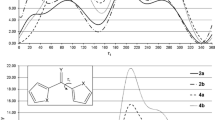Summary
The stability orders for severalcis/trans epimeric hydrindanones and 8-methyl-hydrindanones are shown in a qualitative manner. Starting with the geometry of cyclopentane and cyclohexane changes of Bayer and Pitzer strain existing in the two isomeric bicyclo (4:3:0) nonane systems are discussed. The influences of an angular methyl group (estimated by the simple empirical method evaluated byTurner) and of two new conformational effects (alkyl ketone effects) induced by replacing a methylene group by a carbonyl group are taken into account.
Similar content being viewed by others
References
D. H. R. Barton undR. C. Cookson, Quart. Rev.10, 44 (1956); dort weitere Literaturangaben.
W. G. Dauben undK. S. Pitzer inSteric Effects in Organic Chemistry (M. S. Newman, John Wiley & Sons, New York 1956).
W. Klyne,Progress in Stereochemistry (Butterworth, London 1954).
J. C. Mc Coubrey undA. R. Ubbelohde, Quart. Rev.5, 36 (1951).
E. A. Braude undF. C. Nachod,Determination of Organic Structures by Physical Methods (Academic Press, New York 1955).
J. C. Mc Coubrey undA. R. Ubbelohde, Quart. Rev.5, 36 (1951).
S. Mizushima,Internal Rotations and the Structure of Molecules (Academic Press, New York 1954).
Einer Absprache zwischenH. C. Brown undV. Prelog [J. Amer. chem. Soc.73, 215 (1951)] gemäss bezeichnet man die 5-, 6- und 7 gliedrigen Ringsysteme als gewöhnliche Ringe. Unter der bei diesen zyklischen Verbindungen auftretenden Spannung versteht man einmal die Abweichung der an der Ringbildung beteiligten Valenzwinkel vom jeweiligen energetisch begünstigten Wert: Baeyer-Spannung; die Valenzwinkel der sp3-hybridisierten C-Atome sind bei 109° 28′ spannungsfrei, diejenigen der sp2-hybridisierten C-Atome bei einem Wert von 120°. Als zweite Ursache einer Ringspannung gilt das Auftreten repulsiver Kräfte, die von Atomen oder Atomgruppen ausgehen, die nicht unmittelbar miteinander verbunden sind, sondern sich an benachbarten und übernächsten usw, C-Atomen befinden: Pitzer-Spannung.
K. S. Pitzer, Chem. Reviews27, 39 (1940).
R. B. Turner, J. Amer. chem. Soc.74, 2118 (1952).
W. S. Johnson, Exper.8, 315 (1951); J. Amer. chem. Soc.75, 1498 (1953); Chem. and Ind.1956, 167.
J. G. Aston, S. C. Schumann, H. L. Fink undP. M. Doty, J. Amer. chem. Soc.63, 2029 (1941).
J. G. Aston, H. L. Fink undS. C. Schumann, J. Amer. chem. Soc.65, 341 (1943).
K. S. Pitzer, Science101, 672 (1945).
D. H. R. Barton, Exper.6, 316 (1950).
J. N. Haresnape, Chem. and Ind.1953, 1091.
W. Hückel, M. Sachs, J. Yantschulewitsch undF. Nerdel, Ann.518, 155 (1935).
W. Hückel, M. Sachs, Y. Yantschulewitsch undF. Nerdel, Ann.518, 155 (1935).
W. G. Dauben undK. S. Pitzer inSteric Effects in Organic Chemistry (M. S. Newman, John Wiley & Sons, New York 1956).
S. G. Angyal undC. G. MacDonald, J. chem. Soc.1952, 686.
S. G. Angyal undC. G. Mac Donald, J. chem. Soc.1952, 686.
R. P. Linstead, Ann. Reports32, 306 (1935).
H. G. Drex, Rec. trav. chim. Pays-Bas41, 318 (1922).
W. Hückel undH. Friedrich, Lieb. Ann.451, 132 (1926).
L. P. Kuhn, J. Amer. chem. Soc.74, 2492 (1952).
A. S. Dreiding, Chem. and Ind.1954, 992.
E. L. Eliel undC. Pillar, J. Amer. chem. Soc.77, 3600 (1955).
A. S. Dreiding, Chem. and Ind.1954, 992.
L. P. Kuhn, J. Amer. chem. Soc.74, 2492 (1952).
E. L. Eliel undC. Pillar, J. Amer. chem. Soc.77, 3600 (1955).
E. J. Corey undR. A. Sneen, J. Amer. chem. Soc.77, 2505 (1955).
R. C. Cookson, J. chem. Soc.1954, 282.
H. C. Brown, J. H. Brewster undH. Shechter, J. Amer. chem. Soc.76, 467 (1954).
P. A. Robins undJ. Walker, J. chem. Soc.1954, 3960;1955, 1789; Chem. and Ind.1955, 722.
W. Klyne, Exper.12, 119 (1956).
P. A. Robins undJ. Walker, J. chem. Soc.1954, 3690;1955, 1789; Chem. and Ind.1955, 772.
W. Klyne, Exper.12, 119 (1956).
W. G. Dauben undJ. Jiu, J. Amer. chem. Soc.76, 4426 (1954).
P. K. Banerjee undP. R. Shafer, J. Amer. chem. Soc.72, 1931 (1950).
H. H. Inhoffen undE. Prinz, Chem. Ber.87, 684 (1954).
A. Windaus undW. Grundmann, Lieb. Ann.524, 295 (1936).
K. Dimroth undH. Jonsson, Chem. Ber.74, 520 (1941).
W. Hückel undL. Schnitzspahn, Lieb. Ann.505, 274 (1933).
W. Hückel undE. Goth, Chem. Ber.67, 2104 (1934).
W. Hückel undR. Schlüter, Chem. Ber.67, 2107 (1934).
K. Dimroth undH. Johnsson, Chem. Ber.74, 520 (1941).
D. Crowfoot undJ. D. Dunitz, Nature162, 608 (1948).
C. S. Barnes, D. H. R. Barton undG. F. Laws, Chem. and Ind.1953, 616;D. H. R. Barton undG. F. Laws, J. chem. Soc.1954, 52.
L. F. Fieser undM. Fieser,Natural Products Related to Phenanthren 3 Aulf. (Reinhold, New York 1949), S. 622.
A. Windaus, Lieb. Ann.447, 233 (1926).
F. Sorm, Coll. Czechoslov. chem. Commun.12, 437 (1947).
F. Sorm undH. Dykova, Coll. Czechoslov. chem. Commun.13, 407 (1948).
L. F. Fieser, J. Amer. chem. Soc.75, 4386 (1953).
W. G. Dauben undC. F. Fonken, J. Amer. chem. Soc.78, 4736 (1956).
Author information
Authors and Affiliations
Rights and permissions
About this article
Cite this article
Quinkert, G. Die Stabilitätenreihenfolge der stereoisomeren Hydrindan-und Hydrindanon-Verbindungen. Experientia 13, 381–389 (1957). https://doi.org/10.1007/BF02161107
Published:
Issue Date:
DOI: https://doi.org/10.1007/BF02161107




